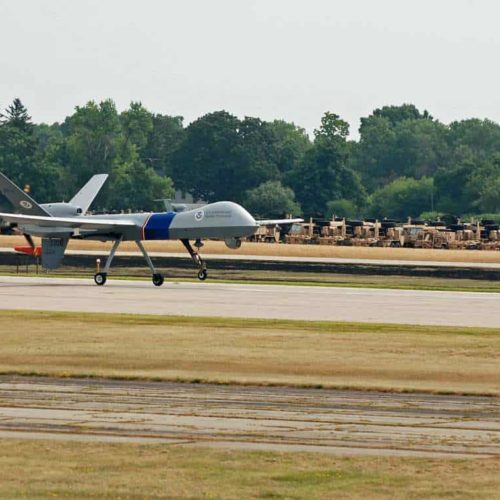Introduction
The key military role played by the over 7,500 drones used by the Pentagon is well-known. But until recently, the deployment of drones by the government inside U.S. borders has attracted little attention or critical oversight.
Now a new internal audit from the Department of Homeland Security (DHS) has raised concerns about the utility of those drones, focusing on their high costs and how they have been managed.
DHS has spent more than $250 million on its program in the past six years, and currently has nine Predator drones on call. While each drone is purchased at a cost of around $18 million each, the GAO estimated that the hourly charge is $3,234 — or almost $65,000 per 20-hour mission.
The majority of the drones are based on the U.S./Mexico border, where a growing drug war has slowly seeped into parts of California and Texas. But drones also scout the border with Canada. Homeland Security Secretary Janet Napolitano testified last month that UAVs were patrolling from North Dakota to eastern Washington State.
The program has had a series of operational troubles, the IG report reveals. For example, the drones have required an hour of maintenance for every hour they fly, significantly increasing their expense. Additionally, inspectors found that the drones were often grounded by bad weather.
As a result, in 2011 the drones logged only half the air time expected. During the year-long period inspectors studied, the drones logged only 37 percent of the minimum desired mission needs and 29 percent of the maximum needed.
This failure to meet expectations hasn’t tempered the government’s enthusiasm. In 2011, DHS asked for and received an additional 2 drones for use on the border. The department is expecting another to be delivered in 2012. Some of the conclusions in a draft version of the IG’s report were first disclosed in May by the Los Angeles Times.
The report recommended that the Customs and Border Protection agency, which manages drone use for DHS inside U.S. borders, put off further purchases of drones until it has figured out a way to use its current ones more fully. It also calls on DHS to create a formal process by which outside groups — including the FBI, the Defense Department, the Texas Rangers, FEMA and the United States Forest Service, among others — can request to borrow drones from DHS and pay for their use. In their response to the report, the agency said it agreed.
According to statistics cited by the Washington Post, the drone program led to the apprehension of 4,865 undocumented immigrants between 2006 and 2011. But this was a mere fraction of the illegal immigrants caught — 327,577 captured in 2011 alone — during this period, and a careful cost-benefit analysis comparing drones to manned surveillance aircraft and mounted patrols evidently has yet to be done.
Some critics have raised privacy concerns. “The deployment of drone technology domestically could easily lead to police fishing expeditions and invasive, all-encompassing surveillance that would seriously erode the privacy that we have always had as Americans,” warned a December report from the American Civil Liberties Union. This week, Sen. Rand Paul (R-Ken.) introduced a bill to ban the use of drones for domestic surveillance, citing similar privacy concerns.
Proponents of drone use note that the drones helped seize almost $20 million in marijuana during 2011. Also, last summer, a drone in North Dakota was used to help arrest a three armed citizens who chased a local sheriff of their property. Police used the drone to pinpoint the location of the men and ascertain that they were unarmed before moving in to arrest them. The incident is believed to be the first domestic arrest made with the aid of drones.
Domestic use of drones seems slated for a sharp increase, no matter what the statistics show, due to the image of battlefield success now associated with military drone use overseas. The Federal Aviation Administration estimates that by 2020, for example, there could be 30,000 drones operated inside U.S. borders. Included in that number are both military-grade drones like those used by DHS on the border, and smaller surveillance craft that are cheap enough to be purchased by local law enforcement.
The Defense Department, in an April report to Congress, lists 110 military bases in forty states where it predicts the military’s drones could be flying by 2017 for what it calls a “wide range” of missions, including testing and training. The report was first disclosed by InsideDefense.com and the Federation of American Scientists “Secrecy News” blog.
In the House, a 55-member, bi-partisan Unmanned Systems Caucus is dedicated to expanding the use of drone technology. Part of the caucus’ mission statement is “the urgent need to rapidly develop and deploy more Unmanned Systems in support of ongoing civil, military, and law enforcement operations.” The caucus is headed up by Defense committee chair Buck McKeon (R-Calif.), a noted friend of the defense industry who has received campaign contributions from multiple drone manufacturers.
Supporters may have the upper hand with public opinion. A poll released Tuesday by the Monmouth University Polling Institute found that two out of three Americans support the use of drones domestically to track down escaped convicts and control illegal immigration at the borders. That support for drone use shot up to 80 percent when respondents were asked if they should be used for rescue operations.
But just in case anyone intends to go overboard, only 27 percent of those polled were okay with drones being used to catch speeders.
Managing editor for national security R. Jeffrey Smith contributed to this article.


Join the conversation
Show Comments